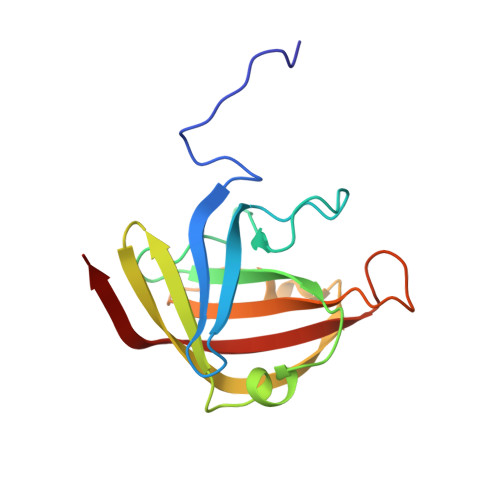Solution Structure of the Sortase Required for Efficient Production of Infectious Bacillus anthracis Spores.
Robson, S.A., Jacobitz, A.W., Phillips, M.L., Clubb, R.T.(2012) Biochemistry 51: 7953-7963
- PubMed: 22974341
- DOI: https://doi.org/10.1021/bi300867t
- Primary Citation of Related Structures:
2LN7 - PubMed Abstract:
Bacillus anthracis forms metabolically dormant endospores that upon germination can cause lethal anthrax disease in humans. Efficient sporulation requires the activity of the SrtC sortase (BaSrtC), a cysteine transpeptidase that covalently attaches the BasH and BasI proteins to the peptidoglycan of the forespore and predivisional cell, respectively. To gain insight into the molecular basis of protein display, we used nuclear magnetic resonance to determine the structure and backbone dynamics of the catalytic domain of BaSrtC (residues Ser(56)-Lys(198)). The backbone and heavy atom coordinates of structurally ordered amino acids have coordinate precision of 0.42 ± 0.07 and 0.82 ± 0.05 Å, respectively. BaSrtC(Δ55) adopts an eight-stranded β-barrel fold that contains two short helices positioned on opposite sides of the protein. Surprisingly, the protein dimerizes and contains an extensive, structurally disordered surface that is positioned adjacent to the active site. The surface is formed by two loops (β2-β3 and β4-H1 loops) that surround the active site histidine, suggesting that they may play a key role in associating BaSrtC with its lipid II substrate. BaSrtC anchors proteins bearing a noncanonical LPNTA sorting signal. Modeling studies suggest that the enzyme recognizes this substrate using a rigid binding pocket and reveals the presence of a conserved subsite for the signal. This first structure of a class D member of the sortase superfamily unveils class-specific features that may facilitate ongoing efforts to discover sortase inhibitors for the treatment of bacterial infections.
Organizational Affiliation:
Department of Chemistry and Biochemistry, University of California, Los Angeles , 611 Charles Young Drive East, Los Angeles, California 90095, USA.














